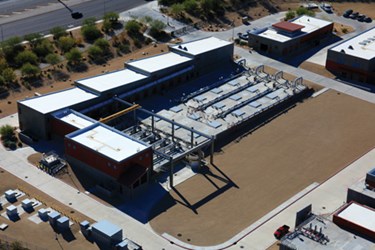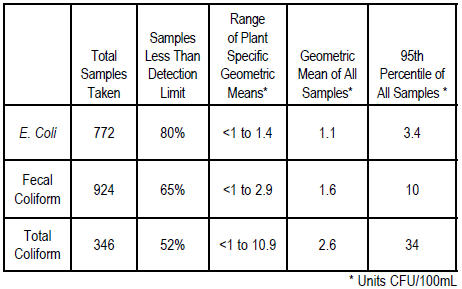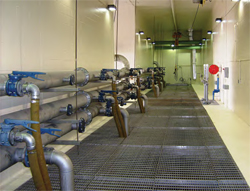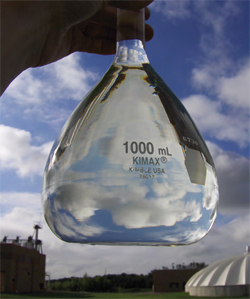The Case For Removing Disinfection From Wastewater Treatment

By Stephen Katz, PE, product manager, GE Water & Process Technologies
Membrane bioreactor (MBR) technology is proven to adequately remove microbial contaminants all on its own, eliminating the time, money, and focus spent on disinfection.
A tremendous amount of pressure is put on municipalities to provide higher-quality effluent within increasingly constrained capital and operating budgets — they are required to do more with less. Wastewater treatment industry stakeholders should strive to understand and prove the capabilities of technology so as to enable the implementation of the required treatment levels within existing budgets. Membrane bioreactor (MBR) technology enables municipalities to effectively remove pathogens without the need — and cost — of an additional disinfection step.
Regulatory agencies provide guidance on safe limits of pathogens in water bodies actively used by the public for recreational purposes. In 2012 the U.S. EPA published recreational water quality criteria (RWQC) for protecting human health for primary contact recreational use, and in 2006 the European Union (EU) published the new Bathing Water Directive, which member states must follow to inform the public of bathing water quality. Since wastewater treatment plants discharge directly into surface waters and can be a source of these pathogens, microbial parameters are generally among their effluent water-quality standards. Historically, regulations have been based on total coliforms, fecal coliforms, or Escherichia coli (E. coli), but have more recently moved to favor E. coli, as it is the only member of the total coliform family exclusively found in the feces of humans or other warmblooded animals and the best indicator of possible presence of intestinal-disease-causing bacteria, viruses, and protozoa. As further protection, facilities are typically mandated to include a disinfection step to the treatment flowsheet.
MBR Efficacy
When considering municipal wastewater treatment by the conventional activated-sludge process (CAS) to achieve effluent quality requirements for microbial indicators, the addition of a disinfection step is required because the CAS process cannot reliably remove indicator bacteria to a low-enough level. In this treatment scheme, microbial removal is partially dependent on the settling of bacterial floc particles, a process which is subject to variability. MBR is considered the best available technology for achieving high-quality effluent, as it achieves secondary and tertiary wastewater treatment in one, compact step. When ultrafiltration membranes are incorporated into the MBR process, the dominant removal mechanism for coliforms is size exclusion. The coliforms may be directly excluded or may be indirectly blocked due to sorption to the activated sludge solids, which are themselves excluded. The presence of a dynamic filtration layer on the membrane surface can further enhance the size-exclusion capabilities of the membrane pores.
To help assess the long-term viability of MBR technology to effectively remove pathogens, GE conducted an extensive multiyear study where more than 2,000 samples were taken at 10 plants of various ages, hydraulic capacities, and geographic locations. Depending on the plant’s effluent requirements, samples were tested for presence of total coliforms, fecal coliforms, and/or E. coli bacteria in the MBR permeate. The results of the sampling clearly showed that the effluent from the MBR systems without an additional disinfection step met pathogen-based surface water discharge standards for treatment plants and were below limits set for water bodies used for recreation. A summary of the results of this study are shown in Table 1 below.
Table 1: Study Data Measuring Microbial Contaminants in MBR Permeate

As the industry accepts the MBR process as a viable means of disinfection, it will be imperative to understand how plant operations will ensure that the MBR system is capable of meeting these microbial limitations. Studies have shown that in MBR operation, with a supported membrane, substantial membrane damage was required to cause a significant increase in contaminant levels. Minor breaches in membrane integrity had negligible impact because of contaminant sorption onto much larger floc in the activated sludge, which are largely rejected even by damaged membranes, and the impact of the dynamic filtration layer. Online membrane permeate turbidity monitoring — which allows for an online means of displaying solids concentrations in the effluent and ensuring membrane integrity — was sufficiently responsive to detect membrane damage that resulted in a significant increase in contaminant levels in the MBR permeate; a turbidity threshold of 0.2 NTU (nephelometric turbidity units) was appropriate for verification of contaminant removal below required limits. (For MBR applications, the measurement of online turbidity is considered the operational standard for monitoring performance of the system.) It is important to note that all of the current guidelines are based on absolute values in the effluent, and therefore the treatment efficacy needs to be independent of the influent concentration of the contaminants.
The Cost Of Disinfection
The addition of a post-membrane disinfection step — such as chlorination/dechlorination, UV treatment, or ozonation — to the MBR flowsheet comes with significant cost, from both a capital expenditure and operating standpoint. The total costs associated with the incorporation of a UV disinfection system into a treatment scheme are significantly more than just the purchase costs of the equipment. It was estimated that the capital cost of including this equipment represents 3.3 percent of the overall capital cost of the project, and the operations and maintenance (O&M) cost represents 2.9 percent of the anticipated total O&M of the entire facility.
Regulatory Cooperation
 Recent cases demonstrate that in certain jurisdictions regulators have granted municipalities the allowance to bypass disinfection due to the permeate quality achieved by the MBR systems. The following two cases provide examples of local regulatory bodies allowing municipalities to shut down their UV disinfection systems.
Recent cases demonstrate that in certain jurisdictions regulators have granted municipalities the allowance to bypass disinfection due to the permeate quality achieved by the MBR systems. The following two cases provide examples of local regulatory bodies allowing municipalities to shut down their UV disinfection systems.
Hutchinson Wastewater Treatment Facility — City of Hutchinson, MN
In 2008, the City of Hutchinson Wastewater Treatment Facility completed a major expansion that included a GE LEAPmbr* filtration system running in parallel to the existing oxidation ditch activated sludge process. The MBR system added 1.27 MGD of capacity to the plant for a total treatment capacity of 3.67 MGD with the ability to treat a peak wet-weather flow of 9.62 MGD. The design included a UV disinfection facility for bacteria removal to reach the city’s permit requirements for fecal coliforms of a monthly mean value of <200 MPN (most probable number) per 100 mL.
Soon after startup, testing was conducted to review the MBR system’s ability to independently meet the discharge requirements without postdisinfection. During the testing, sampling was done as specified by the permit requirements from the MBR effluent and was tested for fecal coliform and E. coli. The results of the testing demonstrated that the amount of fecal coliform and E. coli in the MBR effluent was negligible for all tests. Having validated the MBR’s ability to meet the permit requirements without disinfection, the Minnesota Pollution Control Agency (MPCA) granted the city of Hutchinson permission to bypass the UV system. To date, the Hutchinson facility MBR system continues to produce water within the permit requirements without the additional treatment step. As a result, the city has saved several hundred thousand dollars by not having to purchase previously planned UV facilities, and has reduced operational, electrical, and maintenance costs.
 Southwest Water Reclamation Facility – City of Henderson, NV
Southwest Water Reclamation Facility – City of Henderson, NV
The Southwest Water Reclamation Facility (SWRF) in Henderson, NV, consists of a biological treatment system designed to include nutrient removal followed by a GE MBR system. The MBR effluent is directed to the UV facility, followed by postchlorination. The SWRF is designed to treat annual average daily flow of 8.0 MGD and peaking to an hourly flow rate of 13.6 MGD. The city’s permitted requirements for bacteriological parameters, driven by the reclamation of the water, requires the effluent to meet <2.2 MPN of fecal coliforms per 100 mL as the mean of all samples taken in the month and a daily maximum of 23 MPN of fecal coliforms per 100 mL.
In 2012 and 2013, the municipality conducted a study to validate the treatment facility’s ability to remove various virus and bacteria without the use of disinfection. During this time, samples of the MBR permeate were taken during various phases of operation (i.e., normal operation, high-flux operation, postcitric acid cleaning, and post-sodium hypochlorite cleaning). The samples were tested for total coliforms, fecal coliform, and E. coli, as well as for viruses. The study concluded that the MBR system was very effective at reducing virus and bacteria concentrations to very low levels and, in most cases, to nondetect levels without disinfection.
The city of Henderson was given permission by the Nevada Department of Environmental Protection to bypass the UV system. Postchlorination is still maintained to prevent biogrowth in the reclaimed water system. To date, the Henderson facility continues to bypass its UV system and the MBR system continues to produce water within the permit requirements. As a result, the city of Henderson is currently saving an estimated $93,000 a year in operational costs.
As proven by the data and shown in the case studies above, MBR systems are capable of removing microbial contaminants and, therefore, do not need a disinfection step for discharge to surface waters. This presents a much needed opportunity for municipalities to save money.
*Trademark of General Electric Company; may be registered in one or more countries.
About The Author
 Stephen Katz, PE, is a product manager for GE Water & Process Technologies with more than 10 years of experience in the water and wastewater treatment market. In his current role, he is focused on technical and commercial guidance for membrane bioreactor (MBR) technology, commercialization of new technologies for wastewater treatment, and strategic partnerships for the sale of GE’s equipment portfolio. Katz graduated from McGill University in Montreal, Canada, with a bachelor’s degree in chemical engineering.
Stephen Katz, PE, is a product manager for GE Water & Process Technologies with more than 10 years of experience in the water and wastewater treatment market. In his current role, he is focused on technical and commercial guidance for membrane bioreactor (MBR) technology, commercialization of new technologies for wastewater treatment, and strategic partnerships for the sale of GE’s equipment portfolio. Katz graduated from McGill University in Montreal, Canada, with a bachelor’s degree in chemical engineering.
